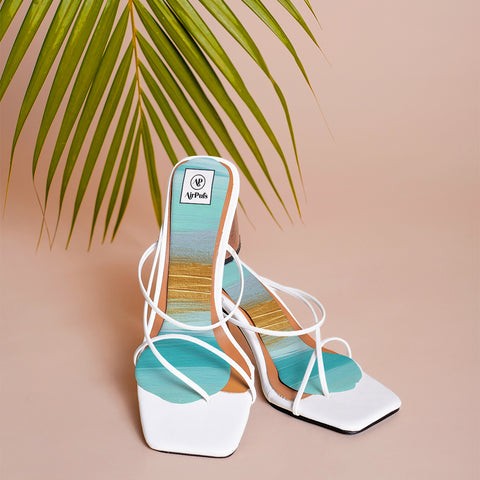Are you struggling to walk gracefully in heels? At LEARNS.EDU.VN, we understand the challenge and offer expert guidance to help you master the art of walking in heels with confidence, ensuring you feel stable and elegant. Discover the secrets to comfortable and stylish strides.
1. Why Is Walking In Heels So Difficult?
Walking in heels can be challenging because it alters your center of gravity. Elevating your heels shifts your weight forward, increasing pressure on the balls of your feet and changing your natural balance. This shift requires different muscles to engage, potentially leading to discomfort and a feeling of instability.
1.1. The Science of Balance in Heels
According to a study by the University of Delaware’s Biomechanics Lab, wearing high heels affects posture and muscle activity. The study found that high heels increase the load on the metatarsals (the long bones in the foot) and can lead to increased strain in the lower back.
1.2. Common Challenges Faced by Beginners
- Instability: The elevated heel reduces the contact area with the ground, making balance difficult.
- Foot Pain: Increased pressure on the balls of the feet can cause discomfort and pain.
- Altered Gait: High heels change the way you walk, leading to an unnatural or awkward gait.
2. Selecting Your First Pair of Heels: A Beginner’s Guide
Choosing the right heels is crucial for a comfortable and confident experience. Start with styles that offer stability and support before transitioning to more challenging designs.
2.1. Prioritize Comfort and Stability
- Low Heels: Begin with heels that are 1-2 inches high to minimize the impact on your balance.
- Block Heels: Opt for block heels, which provide more stability than stilettos.
- Round or Peep Toe: These styles allow your toes more room to move, reducing discomfort.
- Wedges: Wedges offer excellent support and are a great option for beginners due to their even weight distribution.
2.2. Key Considerations When Buying Heels
- Heel Height: Lower heels are easier to manage and cause less strain on your feet.
- Heel Type: Block heels and wedges provide more stability than stilettos.
- Toe Shape: Round and peep-toe styles are more comfortable than pointy toes.
- Material: Leather or soft fabrics can prevent blisters and irritation.
- Fit: Ensure the shoes fit snugly but not too tightly.
2.3. The Importance of Proper Fit
A study published in the Journal of Foot and Ankle Research emphasizes the importance of proper shoe fit in preventing foot problems. Ill-fitting shoes can lead to blisters, bunions, and other painful conditions, especially when wearing heels.
3. Recommended Heel Styles for Beginners
| Style | Description | Benefits |
|---|---|---|
| Kitten Heels | Low heels, typically 1-2 inches, with a slight curve. | Easy to walk in, provides a touch of elegance without compromising comfort. |
| Block Heels | Heels that are thick and square-shaped. | Offers excellent stability and support. |
| Wedges | Heels that run the entire length of the foot, providing even weight distribution. | Comfortable and supportive, ideal for beginners. |
| Ankle Strap Heels | Heels with a strap that secures around the ankle. | Provides extra stability and prevents the foot from slipping. |
4. Comfortable Heel Options for Various Occasions
4.1. Casual High Heels
| Style | Description | Price |
|---|---|---|
| Castaner Carina Embroidery Wedges | Classic espadrille wedges with ankle tie. | $169 |
| Cult Gaia Alia Mules | Stylish mules with a unique architectural heel. | $325 |
| New Look Wide Fit Suedette Block Heel Sandals | Comfortable block heel sandals with a wide fit. | $25 |
4.2. Dressy High Heels
| Style | Description | Price |
|---|---|---|
| Delpozo Kitten Heel Mule | Elegant kitten heel mules with a sophisticated design. | $820 |
| Gianvito Rossi Ruffled Mules | Chic mules with ruffled detailing. | $895 |
| Journee Collection Glitter Pump | Sparkling pumps perfect for special occasions. | $49.99 |
4.3. Work-Appropriate Black High Heels
| Style | Description | Price |
|---|---|---|
| Roger Vivier Belle Vivier Pump | Classic black pumps with a signature buckle. | $860 |
| Franco Sarto Frankie Wedge Pump | Comfortable wedge pumps perfect for all-day wear. | $59.99 |
| Marc Fisher Caitlin Pump | Stylish and versatile black pumps. | $59.99 |
5. Step-by-Step Guide to Walking Gracefully in Heels
Mastering the art of walking in heels requires practice and attention to detail. Follow these steps to improve your technique and build confidence.
5.1. Preparation is Key
- Practice at Home: Wear your heels around the house to get used to the feel and balance.
- Exercise: Strengthen your ankles and calves with exercises like calf raises.
- Break-In: Wear thick socks with your heels to stretch them and prevent blisters.
 High Heel Insoles how to walk in high heels
High Heel Insoles how to walk in high heels
5.2. Mastering the Walking Technique
- Heel-to-Toe: Land on your heel first, then roll forward to your toes.
- Posture: Stand tall with your shoulders back and core engaged.
- Small Steps: Take shorter steps than you would in flats to maintain balance.
- Slow and Steady: Avoid rushing; take your time to walk gracefully.
- Straight Line: Imagine walking along an invisible straight line, placing one foot in front of the other.
5.3. Tips for Walking on Different Surfaces
- Carpet: Practice on carpet to get a feel for the balance.
- Smooth Floors: Be cautious on smooth surfaces, as they can be slippery.
- Stairs: Place the ball of your foot on each step when going up, and your entire foot when going down.
5.4. Improving Your Posture for Walking in Heels
Good posture is essential for both balance and appearance. Imagine a string pulling you up from the crown of your head, keeping your spine aligned and your shoulders back. Engage your core muscles to maintain stability and prevent slouching.
6. Addressing Common Issues and Discomfort
6.1. Dealing with Foot Pain
- Insoles: Use padded insoles to cushion the balls of your feet.
- Foot Exercises: Stretch and massage your feet to relieve tension.
- Breaks: Take frequent breaks to rest your feet, especially during long events.
6.2. Preventing Blisters
- Proper Fit: Ensure your heels fit well to avoid friction.
- Moleskin: Apply moleskin to areas prone to blisters.
- Anti-Friction Balm: Use anti-friction balm to reduce rubbing.
6.3. Insoles and Their Role
Good high heel insoles can provide traction and protect your feet, making a significant difference in comfort. Airpufs insoles, made from NASA-invented material, offer ultra-impact absorption and breathability, helping your foot grip your shoes better.
6.4. Managing Balance Issues
- Practice: Regular practice improves your balance and coordination.
- Core Strength: Strengthening your core muscles enhances stability.
- Awareness: Be mindful of your body’s position and adjust as needed.
7. Post-Heel Care: Relax and Rejuvenate Your Feet
7.1. Essential Aftercare Techniques
- Elevate: Prop your feet up to reduce swelling.
- Massage: Gently massage your feet to relieve tension.
- Soak: Soak your feet in warm water with Epsom salts.
- Compression Socks: Wear compression socks to improve circulation.
7.2. Home Remedies for Tired Feet
- Warm Water Soak: Add Epsom salts or essential oils like lavender for relaxation.
- Foot Massage: Use a ball or hard object to roll under your feet, breaking up stiff muscles.
- Elevation: Lie down and prop your feet up at a 30-degree angle for at least 30 minutes.
8. Additional Tips and Tricks for High Heel Mastery
8.1. Choosing the Right Size and Fit
Visit a shoe store to have your feet professionally measured. Try on heels in the afternoon, as feet tend to swell throughout the day. Walk around the store to ensure the shoes are comfortable and stable.
8.2. Modifying Heels for Better Comfort
Add gel inserts, arch supports, or heel grips to improve comfort and fit. Consider stretching your shoes at a shoe repair shop if they feel too tight.
8.3. Adapting to Different Heel Heights
Gradually increase the heel height as you become more comfortable. Practice walking in higher heels for short periods before wearing them for extended events.
8.4. What Podiatrists Say
According to the American Podiatric Medical Association, wearing high heels can lead to foot and ankle problems if not done correctly. They recommend choosing heels with a wide toe box and a lower heel to minimize stress on the feet.
9. The Psychological Aspect of Walking in Heels
9.1. Confidence and Self-Esteem
Walking confidently in heels can boost your self-esteem and make you feel more empowered. Embrace your personal style and wear heels that make you feel good.
9.2. Overcoming Fear and Anxiety
Start with comfortable, stable heels and gradually increase the height as you gain confidence. Practice in a safe environment and focus on your posture and technique.
9.3. How Heels Can Transform Your Posture and Gait
Heels can improve your posture by encouraging you to stand taller and engage your core muscles. They can also elongate your legs and create a more streamlined silhouette.
10. The Role of Technology in Improving Heel Comfort
10.1. Innovative Heel Designs
Advances in shoe technology have led to the development of more comfortable and supportive heel designs. Look for heels with cushioned insoles, ergonomic shapes, and flexible materials.
10.2. Apps and Gadgets for Foot Care
There are apps available that provide foot exercises and stretching routines. Gadgets like foot massagers and compression devices can also help relieve foot pain and improve circulation.
11. Integrating Heels into Your Wardrobe
11.1. Matching Heels with Different Outfits
Choose heels that complement your outfit’s style and color. Nude heels can elongate your legs and go with almost anything, while statement heels can add a pop of personality.
11.2. Creating a Heel Capsule Wardrobe
Build a collection of essential heel styles that can be mixed and matched with different outfits. Include versatile options like black pumps, nude heels, and comfortable wedges.
12. Debunking Common Myths About Walking in Heels
12.1. “Heels are Always Uncomfortable”
While heels can be uncomfortable, choosing the right style and fit can make a big difference. Look for heels with cushioned insoles, supportive designs, and flexible materials.
12.2. “You Have to Suffer for Fashion”
You don’t have to sacrifice comfort for style. There are plenty of fashionable and comfortable heel options available. Prioritize your foot health and choose heels that make you feel good.
12.3. “Only Certain People Can Walk in Heels”
Anyone can learn to walk in heels with practice and the right techniques. Start with comfortable styles and gradually increase the height as you gain confidence.
13. Long-Term Effects of Wearing Heels
13.1. Potential Foot and Back Problems
Wearing high heels regularly can lead to foot and back problems if not done correctly. Common issues include bunions, hammertoes, and lower back pain.
13.2. Preventative Measures
To minimize the risk of foot and back problems, choose comfortable heel styles, wear them in moderation, and practice proper foot care. Consider orthotics or custom shoe inserts for added support.
13.3. Seeking Professional Help
If you experience persistent foot or back pain, consult a podiatrist or physical therapist. They can provide personalized advice and treatment options.
14. Expert Advice from Fashion Professionals
14.1. Tips from Runway Models
Runway models recommend practicing your walk in heels regularly and focusing on your posture. They also suggest using padded insoles and taking breaks to rest your feet.
14.2. Advice from Shoe Designers
Shoe designers emphasize the importance of choosing the right size and fit. They also recommend looking for heels with ergonomic designs and flexible materials.
14.3. Insights from Style Bloggers
Style bloggers suggest experimenting with different heel styles and finding what works best for your personal style. They also recommend investing in high-quality heels that are both fashionable and comfortable.
15. Resources and Further Learning
15.1. Recommended Books and Articles
- “The правильный Shoe: Fit Your Feet and Walk Away in Comfort” by William A. Rossi
- “Heels: A Comprehensive Guide to Choosing, Wearing, and Caring for Heels” by Tracy DiMarco
15.2. Online Courses and Tutorials
Websites like Udemy and Skillshare offer courses on walking in heels and foot care. YouTube is also a great resource for tutorials and demonstrations.
15.3. Foot Care Professionals and Clinics
Visit a podiatrist for personalized advice and treatment options. Many clinics offer specialized services for heel-related foot problems.
16. Conclusion: Embracing the Art of Walking in Heels
Walking in heels is an art that can be mastered with practice, patience, and the right techniques. By choosing comfortable styles, practicing proper posture and gait, and taking care of your feet, you can confidently rock heels and elevate your style.
Ready to take your heel-walking skills to the next level? At LEARNS.EDU.VN, we provide comprehensive resources and expert guidance to help you master this art. Visit our website at LEARNS.EDU.VN to explore our articles, tutorials, and courses. For personalized assistance, contact us at 123 Education Way, Learnville, CA 90210, United States, or via Whatsapp at +1 555-555-1212. Discover more tips, tricks, and in-depth knowledge that can enhance your confidence and style, only at LEARNS.EDU.VN. Don’t just walk; strut with confidence and elegance! Explore more at learns.edu.vn today!
FAQ: Walking in Heels
-
Is it possible to learn to walk in heels if I’ve never worn them before?
Yes, absolutely! With practice and the right techniques, anyone can learn to walk in heels. Start with lower, more stable heels like block heels or wedges, and gradually increase the height as you become more comfortable.
-
What are the best types of heels for beginners?
For beginners, the best options are kitten heels, block heels, and wedges. These styles provide more stability and are easier to walk in compared to stilettos or higher heels.
-
How can I prevent foot pain when wearing heels?
To prevent foot pain, use padded insoles to cushion the balls of your feet, stretch and massage your feet to relieve tension, and take frequent breaks to rest your feet. Ensure your heels fit properly to avoid friction and pressure points.
-
What exercises can help me improve my balance when walking in heels?
Exercises like calf raises, ankle rotations, and balancing on one foot can help improve your balance and strengthen your ankles, making it easier to walk in heels.
-
How important is posture when walking in heels?
Posture is crucial when walking in heels. Stand tall with your shoulders back, engage your core muscles, and imagine a string pulling you up from the crown of your head. This will help you maintain balance and prevent back pain.
-
What should I do if my heels are too tight?
If your heels are too tight, try wearing thick socks around the house to stretch them out. You can also take them to a shoe repair shop to have them professionally stretched.
-
Are there any specific tips for walking on different surfaces like carpet, smooth floors, or stairs?
On carpet, practice to get a feel for the balance. Be cautious on smooth floors as they can be slippery. When walking up stairs, place the ball of your foot on each step, and when walking down, place your entire foot down in the heel-to-toe sequence.
-
Can insoles really make a difference in heel comfort?
Yes, insoles can make a significant difference in heel comfort. Padded insoles cushion the balls of your feet, provide arch support, and prevent your feet from slipping forward, reducing discomfort and pain.
-
What are some essential aftercare techniques for my feet after wearing heels?
After wearing heels, elevate your feet to reduce swelling, gently massage your feet to relieve tension, soak your feet in warm water with Epsom salts, and wear compression socks to improve circulation.
-
How can I incorporate heels into my wardrobe without sacrificing comfort?
Choose heels that complement your outfit’s style and color, and consider building a heel capsule wardrobe with versatile options like black pumps, nude heels, and comfortable wedges. Look for heels with cushioned insoles, supportive designs, and flexible materials.

